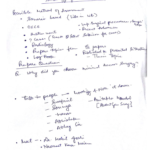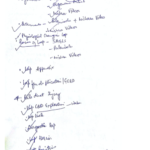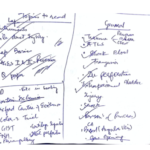My experience with M.Ch. Minimal Access Surgery Entrance Exam
My Experience with Mch, Minimal Access Surgery Exam
Dr. Shardool Vikram Gupta,
M. S. GENERAL SURGERY (UCMS and GTBH, Delhi University), M. Ch. MAS (AIIMS, New Delhi)
First of all I want to emphasise that I am no different than you guys. I may be just slightly more persistent and may have a better strategy. I also acknowledge that there are many paths to similar goal. I am just narrating my way. I shall narrate my story in these subheadings:
{To read PDF file (Click on below link)
1. Strategy for Minimal Access Surgery 2. Materials which I studied
3. The Journey
4. Exam day
5. Preparation for Departmental assessment
6. Departmental assessment
7. between departmental assessment and Result
8. Final take
Strategy for Minimal Access Surgery
Since the course name contained general surgery in it, I made a hypothesis that half laparoscopy and half general surgery should come. I made a plan of reading laparoscopy and general surgery in one and half months. Then till exam there was a plan of revising my read material twice. I made a rough schedule which I changed and adjusted many times due to noncompliance and wasted days.
Materials which I studied
General Surgery
Bailey: first 300 pages and transplant
Sabsiton : Shock ,electrolytes and Fluid ;Principle of Operative and Perioperative Safety;Surgical Infections and antibiotic use; Surgical Complications; Trauma,;Whole GI surgery ( since last KGMC exam I had read GI part of Sabsiton 5-6 times)
Articles: Atlanta modification (2012), Bile duct injury classification
Pritesh MCQ book- GI part only
Laparoscopy
Sages manual: both volumes cover to cover (initial 3-4 chapters of volume 1 are very dry and boring to read, I read them last)
Palanivelu (Art of laparoscopic surgery): General Laparoscopy Article on Ergonomics by Indian author
MAMC update 2015 ergonomics chapter
Lap mcqs from RUSH review and Schwartz pretext
Multimedia Content
R K Mishra plus SAGES Videos
(R K Mishra’s and SAGES you tube channel has nice collection of videos which also helped me in OSCE during departmental assessment)
(While reading SAGES manual, i use to see corresponding videos from aforementioned source first and then proceeded to respective chapters)
Planned to Read these, but couldn’t
General Surgery from RUSH review and Schwartz pretext Whole general surgery from Sabiston
The journey
Mch in minimal access surgery was started for the first time for Jan, 17 session. I was preparing GI surgery before I switched to MAS. It was a tough decision. After weighing pros and cons, I decided to go for MAS.
I started to follow my schedule. I use to read in reading room of UCMS. Few friends of mine reading there became irregular. It was hard to read alone, for man is a social animal. Then I decided to form WhatsApp group of like-minded people (Target Minimal Access Surgery2017). I found wonderful people there like Dr Venky, Dr Kunal Sayani and Dr Pramod Lokhare. I now wish them to meet them in person.
I had many ups and downs, wasted few days and kept on adjusting my schedule (I have this syndrome since birth and I think its incurable). But I remained persistent and revised my read material twice before exam.
The Exam Day
Paper was slightly on easier side but just as I thought, a good blend of general surgery and minimal access surgery. I marked all questions. After compiling paper with help of friends in Target MAS group in Whatsapp and matching my paper, I guessed my score would be ~ 68-72 out of 80. I hoped I would clear the written part. I wished to read for interview but I couldn’t, again due to my congenital syndrome.
Preparation for Departmental Assessment
After theory paper result, I asked few selected people and few talented friends for advice. No one really knew how this viva was going to be. I also came to know that there are 4 internal candidates of aiims. One of my good friends told me that they would take internal candidates only. I was depressed at this instance. I talked to Dr Kushal Bairoliya and Dr Pramod Lokare. They told me aiims pick genuine guys (actually exam process was quite transparent and I am example of that). I was relieved a bit and decided not to think about it and give my best. I formed a strategy something like this (See attached pdf document).

I decided that topics from question paper are important and read these(See attached pdf file).


I also practiced to utter what to say in viva because sometimes we are not able to say all we know
Departmental assessment
It was divided into 3 parts 1. OSCE /Spotting
2. Viva + instruments
3. Lap simulation
1. OSCE / Spotting
There were 5 spots: 3 picture and 2 videos of short duration. Spot 1: picture of critical view of safety and its importance
Spot 2. Intraoperative video of bleeding Cystic artery/aberrant right hepatic artery, how would you manage this complication?
Spot 3: intraoperative video of inadvertently ligating and cutting the CBD Spot 4: I wasn’t sure but most probably it was a TEP view of hernial sac
Spot 5: CECT picture of Hydatid cyst and its management
2. Viva plus instruments
I greeted with 5 examiners sitting behind the table full of Laparoscopic instruments. They inquired me about my college and unit background. I was asked following questions:
Q1. Why did you choose Minimal access surgery? Is MAS good for surgeon or the patients?
Q2. What is this instrument (optical tocar), how is entry into abdomen is made with this, this is disposable or reusable, how is this sterilized if reusable?
Q3. How is this used (Veress needle), how ll you insert this (show me how ll you hold this), if you are not able to insert in 3 times attempt what ll you do?
Q4. Show me the instrument lying in the table which work on bipolar energy (I picked ligasure), what’s name of the instrument, how it works?
Q5. How RCT is beneficial, what is level of evidence of Metanalysis and RCT?
This is just an overview. Actual viva was more complex but all examiners emphasized on basics only.
3. LAP simulation
Porcine hepatobiliary system was assembled in a lap simulator and we were asked to dissect the GB from Liver bed. I had earlier performed two independent lap cholecystectomies in UCMS (thanks to my senior Dr Faizul Haque). Still I perforated the gall bladder. But I proceeded with what was required to manage the complication. I guess it was not a test of how quickly you remove the GB, rather it was an assessment of hand eye coordination, intraoperative assessment of situation and handling complication.
Between Departmental Assessment and final result
I talked to other qualified candidates after departmental assessment. Few told the truth. Some exaggerated their viva and made me scared. I planned to read for upcoming DNB exam in case I wasn’t selected, but I couldn’t read much. Those 3-4 waiting days were quite scary but I finally got rank 1 and it was worth the wait.
Final Take
Ups and downs come in everyone’s life. If some of your days are going bad and if you are lagging behind, regroup your courage and strength and start afresh. Everyone is in same boat; difference is of persistence and implementing your strategy. Remember, revision is the key.
PDF file (Click on below link)